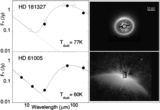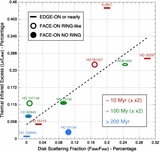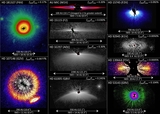Image Details

Caption: Figure 13.
(A) HD 15175 ACS discovery image (from Kalas et al. 2007a; see Figure 1). The central masked region r = 1'' but "the presence of quasi-static speckles produces significant PSF-subtraction residuals, limiting the detection radius to ~2 arcseconds," (p. 161). (B) STIS three-roll combined image (visits B5–B8 only) improves over ACS IWAeffective = 2'' undegraded from residuals by ~×7 to IWAeffective = 0![]() 3 (19 AU projected; central yellow circle). The dotted black circle corresponds to the r = 1'' digital mask imposed on ACS image in panel (A). The solid gray circle corresponds to the larger r = 2'' effective IWA in the ACS. Log10 display [−2.2] to [+2.5] {dex} cps pixel−1. (C) Same STIS data as panel (B), but with the disk major axis rotated to image horizontal and log10 monochrome display [−1.5] to [+1.5] {dex} cps pixel−1. Field shown: 350 × 350 STIS pixels (17
3 (19 AU projected; central yellow circle). The dotted black circle corresponds to the r = 1'' digital mask imposed on ACS image in panel (A). The solid gray circle corresponds to the larger r = 2'' effective IWA in the ACS. Log10 display [−2.2] to [+2.5] {dex} cps pixel−1. (C) Same STIS data as panel (B), but with the disk major axis rotated to image horizontal and log10 monochrome display [−1.5] to [+1.5] {dex} cps pixel−1. Field shown: 350 × 350 STIS pixels (17![]() 75 × 17
75 × 17![]() 75). N.B.: point object (revealed as binary with STIS) is non-common proper motion background star superimposed on the disk, as determined with NICMOS (2004)/STIS (2012) two-epoch data.
75). N.B.: point object (revealed as binary with STIS) is non-common proper motion background star superimposed on the disk, as determined with NICMOS (2004)/STIS (2012) two-epoch data.
Copyright and Terms & Conditions
© 2014. The American Astronomical Society. All rights reserved.












